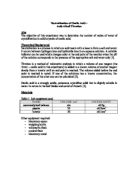Average Volume of NaOH solution: (24.6+24.8+24.7)/3 = 24.7cm³.
Processing of Results:
(COOH)₂.xH₂O (aq) + 2NaOH(aq) (COONa)₂ (aq) + 2H₂0(l)
Number of moles of NaOH = = (24.7/1000) x 0.1 = 0.00247
Number of moles of (COOH) ₂ = 0.00247/2 = 0.001235
Number of moles of (COOH)₂ in 250 cm3 =( 0.001235/25.0) x 250 = 0.01235
Mr of (COOH)₂.xH₂O = =1.5/0.1235 =121.457 = 121
Mr of (COOH)₂.xH₂O = 2(12.01+16+16+1.01) + 18x = 90.04 + 18x
x = (121-90.04)/18 = 1.72
Uncertainties:
Uncertainty in mass of oxalic acid crystals= 0.02/1.5 x 100% = 1.33
Uncertainty in volume of water used= 0.3/250 x 100%=0.12
Uncertainty in volume of aqueous oxalic acid used= 0.06/25 x 100%= 0.24
Uncertainty in volume of NaOH=0.2/24.7 x 100% = 0.8
Total uncertainty= 2.49% approx
Thus, the number of moles of water of crystallization in oxalic acid = 1.72 to 3 sig fig +/- 2.49%
= 1.72 to 3 sig fig +/- 0.0428
The literature (true) value of the number of moles of water of crystallization in oxalic acid is given as 2 so the percentage error in the result is as follows:
(1.72-2)2x 100%=14%
We can conclude that the experiment gave a reasonably accurate value for the number of moles of water of crystallization in oxalic acid, since the percentage uncertainty is not considerably high and there isn’t a very significant difference between the calculated value and literature value of the number of moles of water of crystallization in oxalic acid. This shows that the experiment had systematic errors which caused this inaccurate value.
Do the uncertainties in the apparatus account for this percentage error? No, if we take into account the uncertainty of +/- 2.49, the experimental relative atomic mass value ranges from 1.76 to 1.68. This range does not incorporate the true value of the number of moles of water of crystallization in oxalic acid, so we can see that there must be other random or systematic errors in the experiment.
Possible Sources of Error:
The experiment has limitations that could have been improved or avoided. There were multiple human errors which affected the accuracy of the experiment and the true value of x. For example, when we were making up our original solution of aqueous oxalic acid, we filled up the distilled water to more than 250 cm³; therefore having a slightly larger amount and this may have made the solution slightly more dilute and affected the proper result. Overall, the results we attained were quite precise as they were in a range of 24.6 – 24.8 cm³ensuring that there were no major errors when performing the experiment. There was also the inaccuracy of determining whether the correct color change has occurred or not. There were some cases when the ‘ting of pink’ was too light or too dark.
Also, there was difficulty in controlling the knob which pours out the original solution of aqueous oxalic acid. At times, the burette would pour out the solution at a fast rate, making it difficult to determine the exact volume needed for the neutralization to take place. This might have led to estimating the volume sodium hydroxide required to neutralize the aqueous oxalic acid solution. It was also difficult to determine the exact amount of volume by the naked eye. This inaccuracy could have been improved by trying to diminish human errors; slowly turn the knob of the burette and allow only a few drops of the solution in the burette to pass through. This might not always happen, but being extra careful will improve the accuracy. Make sure the conical flask is swirled after every few drops so that you know whether the neutralization has taken place or whether the solution is still colorless. As we saw in the experiment, there were signs of the color pink in the flask but as we swirled the conical flask, the pink color disappeared, meaning we needed to add more sodium hydroxide solution.
Repeating the experiment is another way to improve the accuracy. Due to time constraints we were only able to repeat the experiment three times, however we achieved very precise results therefore we can conclude that the experiment was quite accurate. However, improvements can be made by repeating the experiment about 5 times with the same variables and measurements and having more precise results with a difference of probably 0.05 cm³ than 0.1 cm³ as attained in the experiment. We can also consider the inaccuracies of the equipment used, for example the balance scale kept on giving a range of values for the mass of the weighing bottle, resulting in us choosing a value from that range. This causes an inaccuracy because the exact mass of oxalic acid crystals needed to make the solution may not have been used.








